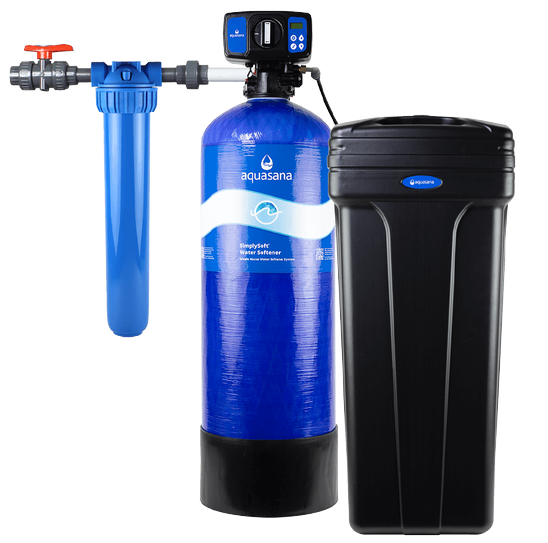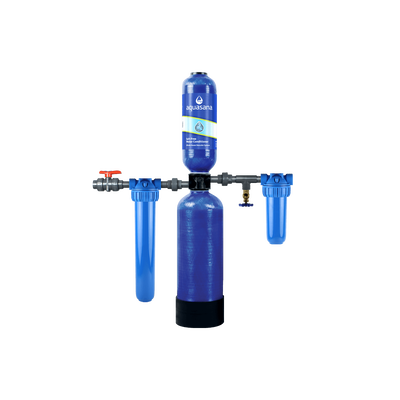For most homes, the solution to hard water is installing a water softener. Water softeners use a process called ion exchange to reduce excess minerals in hard water, effectively “softening” it. In this guide, we’ll walk through everything you need to know about water softeners including:
- Why soft water is better than hard water
- What a water softener is
- How they work
- Types of water softeners
- Parts of a water softener
- How water softener regeneration cycles work
- Do I need a water softener?
- Benefits of water softeners
- Installation and maintenance of a water softener
Why is soft water better than hard water?
If you live in an area with hard water, you’ll likely recognize some of the signs in your home. Depending on the hardness of your water, you may have noticed things like spots or film on your dishes and leftover residue on your hands after using soap. These are the small annoyances, but the more severe and sometimes unnoticeable signs of hard water include:
- Scale buildup in pipes, reducing water pressure and potentially leading to bursts
- Reduced life and efficiency of appliances such as dishwashers, washing machines, and fridges that have to work harder
- Poor performance of soaps and detergents, which require you to use more products
- Increased costs of heating water
- Damaged hair and skin
- Faster fading and deterioration of your clothes
Soft water does not have these issues because it lacks the excess minerals to cause them. As a result, soft water is better for your home and health, and many homeowners dealing with hard water use water softeners to address the issue.
What is a water softener?
A water softener is a system you can install in your home to treat hard water. The water treatment system uses a process called ion exchange to reduce minerals like calcium and magnesium from your water. By removing these minerals, the water is softened to prevent issues associated with hard water.
How do water softeners work?
Water softeners use a process called ion exchange to reduce hard water minerals in tap water as it enters home through the main water line. When hard water flows into the water softener, it passes through a bed of resin beads which are charged with sodium or potassium ions from adding pellets. The beads act like a magnet, pulling the hard mineral ions from the water and replacing them with the beads’ sodium and potassium ions. This results in the hard mineral ions sticking to the beads rather than the water.
After the ion exchange process, the hard mineral ions get removed from the beads and flushed out of the system as wastewater. The softened water passes over the resin beads and recharges them through a process known as regeneration before making its way out for use.
Types of water softeners
There are several choices you can make when choosing the best type of water softener for your home. Here are the four different types:
- Salt-Based Softeners: Salt-based water softeners use the ion-exchange process to replace hard water minerals such as calcium and magnesium. It is considered the traditional water softener and the most commonly used for most homes. It is effective, but requires regular maintenance and frequent salt or potassium pellet refills. Tip: Potassium chloride and sodium chloride are both water softening salts and are equally effective. The main difference is that you need more potassium chloride to soften water than you do sodium chloride.
- Salt-Free Softeners: Also known as conditioners or descalers, salt-free systems use template-assisted crystallization (TAC) to change the properties of the hard water minerals, which prevents them from sticking to surfaces and creating buildup in your pipes. Technically, the TAC process doesn’t change your hard water to soft water, but it does address hard water by rendering the hard minerals harmless.
- Dual-Tank Softeners: Dual tanks use two resin tanks so that your water is always being softened, even during regeneration. One tank will be softening your water, while the other regenerates with salt or potassium pellets.
- Magnetic Softeners: Similar to salt-free systems, these softeners change hard water minerals rather than removing them. Using magnetic fields, these softeners strip negative and positive ions from hard water to magnetize the particles and neutralize them. However, there’s controversy about the effectiveness of magnetic softeners, with conflicting reports about if they actually work.
WATER SOFTENERS
SimplySoft® 60,000 Grain Softener
Tackles hardness-causing minerals, delivering soft, scale-free, and spotless water throughout your home.

Parts of a water softener
While each system is unique, softeners are generally comprised of the following components:
- Mineral Tank: A storage chamber filled with small resin beads that attract and remove hard minerals from water. It is the main component in the water softener.
- Control Valve: A measurement tool that regulates the regeneration cycle by measuring the amount of water entering and leaving the mineral tank.
- Resin Beads: Small spherical plastic beads made of polystyrene that are charged with a sodium or potassium ion. The beads attract the hard minerals and swap ions to remove the minerals from hard water.
- Brine Tank: A storage chamber for the salt or potassium solution. The solution is flushed through the mineral tank during the regeneration cycle in order to clean and recharge the resin beads.
- Riser Tube: Allows for water movement while in use and during regeneration.
- Bypass Valve: Used to divert water from the tank. This may be necessary when performing maintenance on your water softener or if you need softened water for tasks such as watering plants.
- Drain Line: A line used to drain the excess hard minerals and brine solution from your water softener during the regeneration cycle.
How water softener regeneration cycles work
The regeneration cycle is a part of the softening process that involves rinsing beads with a brine solution to wash off the hard minerals, recharge the resin beads, and flush out the wastewater. This not only cleans the system, but prepares it for the softening process to start over again.
There are two means of regeneration:
- Timer Controlled: Regeneration is set to a schedule, like once a week or daily.
- Meter Controlled: Regeneration happens based on usage, typically after a specified amount of water passes through the softener.
Metered regeneration is the more efficient and cost-effective method, since it occurs as you use it rather than a pre-defined schedule. This means softened water doesn’t get wasted if you don’t use it in time. Depending on the softener, regeneration times can typically take between 1-2 hours. While regeneration is occurring, water is not being softened (unless you have a dual-tank softener) which means any water you use will be hard. During this time, it’s recommended to use as little water as possible in order to avoid buildup in your pipes and water heater. Tip: Set your regeneration cycle to happen at night when very little water is being used!
Benefits of water softeners
While the price of water softeners can make some people hesitate, there are several benefits that may make this an easier decision:
Extend appliance lifespan
Hard water causes buildup and limescale on your favorite appliances such as dishwashers, washing machines, and water heaters. Softeners help to reduce buildup and improve the efficiency of your appliances, extending the life of your appliances and reducing the need for replacements.
Protect pipes from bursts
Like appliances, pipes can also suffer from mineral buildup, which leads to reduced water flow and water pressure. This puts your pipes at risk of bursting. Softeners can reduce these minerals and help maintain the health of your pipes.
Improve cleaning product effectiveness
Hard water minerals keep your soaps from lathering, which makes cleaning more difficult and requires you to use more product than necessary. Using soft water means your cleaning products will work more efficiently, saving you money.
Get healthier skin and hair
Hard water can cause dryness, break outs, and irritation to your skin and hair when you wash with it. It does this by leaving a residue of harsh minerals on your skin and hair while also stripping them of their natural oils. Soft water is more gentle, leaving you with healthier skin and hair.
Streak-free dishes
Hard water will leave residue and spots on your dishware after washing. Soft water will keep your dishes spot-free and sparkling by preventing the residue from forming.
Better, longer-lasting clothes
Hard water causes clothes to fade faster, leaves mineral deposits, can create holes, and leave them stiffer and dirtier than you’d get with softened water. Water softeners not only protect your clothes, but also improve the effectiveness of your laundry detergent. Your clothes will come out feeling cleaner and softer, and you’ll also notice they lasting longer.
Higher quality water for drinking and cooking
Hard water may have a bitter, salty, or chalky taste that’s not pleasant to drink and can affect the food you cook. Softened water improves water quality, making it more appealing to drink and helping your food taste better.
Installation and maintenance for water softeners
Installation for water softeners varies by system, so we recommend looking at the product’s documentation to see if the manuals and videos are clear. You may be able to install the system yourself if you have plumbing knowledge, but more complex installations could require you to hire a professional.
As for maintenance, you’ll need to replace the salt or chlorine pellets regularly. Many softeners feature technology to notify you when it’s time for a replacement, but most homes will require you to replace pellets every 6-8 weeks. Additionally, you’ll need to clean the brine tank about once a year.
Address hard water with Aquasana
If you live in an area with hard water, a water softener can prevent issues that cause damage to your home and health. You can extend the lifespan of appliances, help prevent clogged pipes, improve skin and hair health, and other benefits.
At Aquasana, we offer two options of Softeners that can address hard water and a Salt-Free Water Conditioner that can address scale buildup. Any of these systems can be paired with a whole house water filter to protect against additional contaminants. Shop systems or contact one of our Water Experts to find the best set-up and configuration for your needs.



